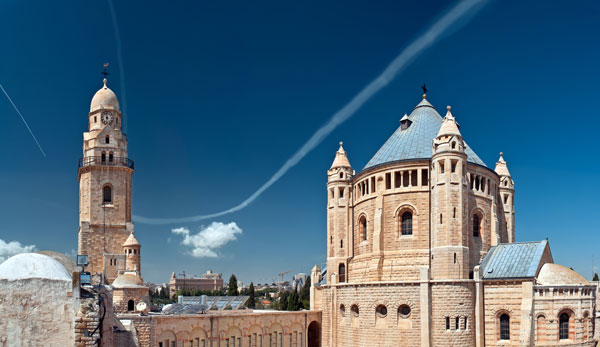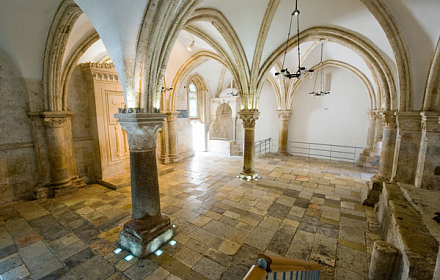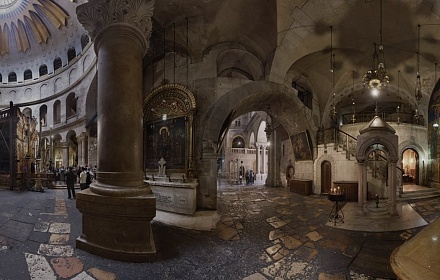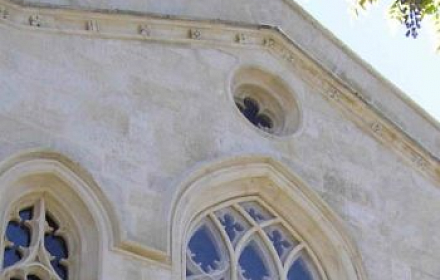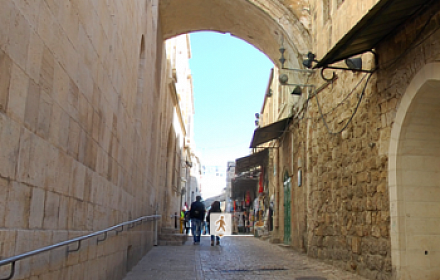About Virtual Tour
Entrance
Basilica of the Dormition is located on the premises of the Abbey of the Dormition that belongs to Catholic Benedictine monks. Although the modern building was constructed in late 19th—early 20th century, the church has a long history that started in the times of Byzantine Empire, and reflects architectural styles of Europe and Middle East. Let's go on a virtual pilgrimageIn the 5th century AD the Byzantine basilica Hagia Sion stood on this spot, a hundred years later destroyed during Persian invasion by the warriors of king Khosrow II. After the Persians were driven away, a major reconstruction started, which led to discovery of a stone slab, upon which, according to Christian tradition, the Blessed Virgin Mary mother of Jesus fell into an eternal sleep. The stone became the main relic of the new church, which was consecrated in honor of the Dormition, which in Latin means “sleep”.
In late 19th century the plot of land was acquired by the German government — Kaiser Wilhelm II personally participated in this matter. Not surprisingly, the Turkish authorities could not turn down the request from such an influential mediator, as they needed a powerful European ally. Since then, the place and the church have belonged to the German Union of the Holy Land with bishop of the city of Cologne nominated as its president. Heinrich Renard, a German from Cologne himself, was selected as the main architect for the church and the abbey.
The exterior of the church impresses with its eclecticism, which is quite unusual for the Old City’s buildings. However, its most interesting highlights are hidden inside – and that’s where we’re going.
Basilica
The main relic of the Dormition is in the crypt — an underground room beneath the church. This is the Dormition Stone from the house of St. John the Evangelist, upon which expired Virgin Mary and her soul was taken by Her divine Son. Afterwards, according to tradition, her body miraculously disappeared from the tomb and escaped corruption — but this is another story.
Today a sculptural image of the lying Holy Virgin stands upon the historical stone. Above her is spread a baldachin featuring depictions of six women of the Old Testament, from Eve to Esther — surrounding the figure of the Son of God, who addresses His mother with the words from the biblical Song of the Songs: “Arise, my love, my fair one, and come away. O my dove, that art in the clefts of the rock” (Song of the Songs 2:13/14).
The sculptural image of Virgin Mary on the ancient stone is recognized as miraculous by Western Christians. Every day the crypt is always crowded with pilgrims, mostly women, who bend over to kiss it with veneration or to touch it gently with their hands: it is believed that Holy Mother gives special attention to women’s prayers…
The stone with the figure of Virgin Mary is surrounded by six altars, each designed in its own unique style. They are gifts presented to the church from various countries: Austria, Brazil, Ivory Coast, Hungary, Venezuela and United States of America. Depictions of Apostles and saints on these altars display local colors and unique stylistic features inherent to each of the above-mentioned countries. Nevertheless, so diverse as they are, grouped together they look quite natural.
The main altar in this part of the church is dedicated to Dormition. One of the frescos depicts the Holy Apostles beside the body of the Virgin, and our Lord Jesus Christ taking her soul to heaven. There are also images of the modern-day Dormitio and its predecessor – Byzantine basilica Hagia Sion. A pillar beneath the altar is a fragment of a Byzantine column, miraculously preserved after one thousand and five hundred years.
Dormition Stone
The interior of basilica’s main hall is filled with the idea of unity between the Old and the New Testaments. Indeed, as Satin Augustin put it “The New Testament in the Old lies concealed the Old in the New is revealed”.The central image of the apse is the Mother of God with Infant Jesus Christ in her hands. Beneath there are figures of eight Old Testament prophets: Haggai, Zechariah, Daniel, Ezekiel, Jeremiah, Isaiah, Malachi and Micah.
Round the altar there are six chapels. One of them is dedicated to the martyr Saint Boniface – Benedictine archbishop and patron saint of Germany. Another chapel is in honor of St. John the Baptist (the Forerunner), and was built with the funds raised by the Maltese order. He is depicted during his sermon on the river Jordan, pointing at Jesus Christ with the following words: “Behold! The Lamb of God who takes away the sin of the world!” The third chapel is dedicated to Joseph the Betrothed and features depictions of the Savior’s ancestors, placed in the Gospel of John chronology. This chapel is a gift of the Maltese order of Silesia.
Reliefs created by Jerusalem masters Sarah and Simon Medina depict the Nativity scenes, the escape of the Holy Family to Egypt, and finally, the death of Saint Joseph.
The chapel of the city of Cologne, which stands to the right of the altar, is dedicated to the Magi who predicted the birth of Christ and brought gifts to the infant Jesus. These wise men are considered patrons of Cologne, their relics rest inside the magnificent cathedral of this German city. There are also many depictions of saints holding church models in their hands, each of them contributed in some way to construction thereof. Next comes the Saint Willibald chapel, a gift from a Bavarian pilgrims society. He is known for his missionary work in European countries and written evidence of his long pilgrimage to the Holy Land. After Saint Boniface was martyred, Saint Willibald took his place.
And finally, the sixth chapel was built by Benedictine monks in honor of Saint Benedict, who lived cloistered life and founded the Benedictine monastery of Monte Cassino and wrote its typicon, which can be summed up in one simple guidance: “Pray and Work”.
The abbot demanded three things from persons taking monastic vows: obedience, humility and change of worldly habits to monastic ones. Saint Benedict is considered to be the founding father of Western monasticism. The statue inside the chapel presents him holding a book in his hands — the typicon that he wrote. In the center there is a depiction of the cross of Saint Benedict, easily recognized by every Catholic — around of which are scenes from the saint’s life. Benedict is considered to be the patron saint of France; Fleury Abbey in Saint-Benoît-sur-Loire possesses his relics.
The Dormitio’s floor mosaic is worth mentioning. In the middle there are three rings with the inscription of the Greek Trisagion that reads: “Agios, Agios, Agios!”, surrounded by three more rings featuring the names of four great prophets, twelve minor prophets and Zodiac signs. The entire surface of the floor is covered with rays emanating from the divine center and symbolizing His reviving divine power that pervades all living beings… What strikes you, even from far, is the floor mosaic in the main hall and in the crypt — It is no exaggeration to say that visitors and pilgrims spend hours examining them.
Street
The Dormitio is more than a Catholic church in the abbey that has the same name. It’s a large cultural area and a common venue for church music concerts that draw the real connoisseurs of the classic. In the Holy Land it is hard to surprise anybody with a gift shop inside a church, but here there is even a cafeteria for visitors. It’s traditionally attributed to the fact that the original church Hagia Sion, which stood on this site in the 5th century was dedicated to the Last Supper. This cafeteria inside the church is meant to make you feel as one of its participants at least for a short while.By the way, it’s right here in the Abbey of the Dormition that archaeologist, bible scholar and Benedictine monk Bargil Pixner spent the last years of his life; the significance of his impact on Bible study can hardly be overestimated.
Finally — one more page from the history of this church. In 1974 Catholics and Jews, a Christian priest and a rabbi lined from the Dormition to the Catholic cemetery for a funeral procession. On that day Christians and Jews were together to participate in the funeral service for Oskar Schindler, recognized as a Righteous among the Nations — a prominent German industrialist and Catholic who saved the lives of over 1200 Jews during the Holocaust. He instructed to bury him in Jerusalem — it was done by thankful people of different nationalities and religious confessions.
Send donation
If you are in a difficult financial situation, we will light the candle for free. For that purpose email us at coordinator@santosepulcro.co.il
Payment Methods
